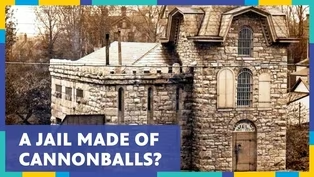Living St. Louis
I am St. Louis: Wainwright Building
Clip: Season 2025 Episode 23 | 4m 56sVideo has Closed Captions
The Wainwright Building had significant influence on modern architecture.
As part of the Missouri Historical Society’s civic pride initiative, President Jody Sowell shares with Nine PBS producer Veronica Mohesky the story of the Wainwright Building, credited as one of the first skyscrapers that had significant influence on modern architecture.
Problems playing video? | Closed Captioning Feedback
Problems playing video? | Closed Captioning Feedback
Living St. Louis is a local public television program presented by Nine PBS
Support for Living St. Louis is provided by the Betsy & Thomas Patterson Foundation.
Living St. Louis
I am St. Louis: Wainwright Building
Clip: Season 2025 Episode 23 | 4m 56sVideo has Closed Captions
As part of the Missouri Historical Society’s civic pride initiative, President Jody Sowell shares with Nine PBS producer Veronica Mohesky the story of the Wainwright Building, credited as one of the first skyscrapers that had significant influence on modern architecture.
Problems playing video? | Closed Captioning Feedback
How to Watch Living St. Louis
Living St. Louis is available to stream on pbs.org and the free PBS App, available on iPhone, Apple TV, Android TV, Android smartphones, Amazon Fire TV, Amazon Fire Tablet, Roku, Samsung Smart TV, and Vizio.
Providing Support for PBS.org
Learn Moreabout PBS online sponsorship♪ Amen - I'm Veronica Mohesky.
Today, I'm here with Jody Sowell, President of the Missouri Historical Society.
And, today, we're going to talk about a rather tall tale.
- If St.
Louis could introduce itself, it would say, "I'm the place that defined what a skyscraper should look like."
The Wainwright Building opens in 1891 in downtown St.
Louis on Chestnut.
It is not in fact the first skyscraper in the United States, but it does become the model for every skyscraper afterwards.
Frank Lloyd Wright talks about, "This is the model for every tall, steel office structure that comes after," PBS names it one of the 10 buildings that changed America.
It's certainly beautiful, but it was also its strong, vertical columns that accentuated its height and made it look even taller than its 10 stories that are really what make it so important, not just in architecture history, but American history.
- Absolutely.
Well, thank you, Jody.
- Welcome.
- I talked to Andrew Wanko to learn more about this historic building.
- You know, you walk past the Wainwright Building in downtown today, and I imagine most people have no idea they're walking past something of any importance.
- [Veronica] That's Andrew Wanko, a Public Historian at the Missouri Historical Society.
- It was never even the tallest building in St.
Louis when it was built in 1891.
The old courthouse just down the street is actually taller than the Wainwright Building.
So how could it possibly be the first skyscraper not even just in St.
Louis, but anywhere in the world?
- [Veronica] But the height of this 10 story building isn't what makes it notable.
- It didn't just soar, it taught all other buildings how to soar.
- [Veronica] In the late 1800s, downtown real estate was extremely valuable, but St.
Louis was running out of space.
- If you could build your building up higher, you could get a lot more building for a lot less money.
So all this new technology that was coming out at the time, things like elevators that could carry people up to floors high in the sky, steel frames that let the exterior walls of buildings essentially hang off the frame like a curtain, they no longer had to bear all that weight of the structure.
You could build buildings theoretically as tall as you wanted to, but architects really struggled with what to do with these new really tall buildings.
And in 1891, Architect Louis Sullivan would provide that on 7th Street in downtown St.
Louis.
Louis Sullivan was a Chicago architect who absolutely poured every ounce of his energy into solving the problem of the skyscraper, coming up with a new form that these tall buildings could take.
And on the Wainwright Building, that's where all of his ideas came together in a huge new way.
- [Veronica] The building was for the Wainwright Brewing Company.
The owners planned to rent out unused floors to other businesses.
Sullivan came up with a unique design for the project by looking at Greek and Roman temples.
- [Andrew] He looked at the columns and realized they were made of three very simple parts; He had a base at the bottom, a shaft in the middle that could rise as tall as you needed it to, and then the capital on top was this explosion of decoration.
- [Veronica] This decoration is now called Sullivanesque design, and it earned him praise and distinction.
- He interlaced these geometric patterns with leafy, vegetative motifs.
It was a totally new form of decoration for a new American architecture, and really set this new kind of moment in motion when all of a sudden you had all of these other architects realizing this is the new path to take.
Architect Frank Lloyd Wright, easily one of the most famous American architects of all time, was actually working in Sullivan's office at the time the Wainwright Building was going up, and later said that that was one of the most important moments, not just of Sullivan's practice, but of his own, seeing an idea like that come to life in a huge new way.
- [Veronica] The building was completed in 1891.
- So the Wainwright Building, he would refer to as the single moment in his career, from that point forward, all other buildings he designed would point back to the Wainwright Building as their sort of common source.
Louis Sullivan became known as the Father of Skyscrapers, and did more than any other American architect to define what a skyscraper should look like.
- [Veronica] And despite its historical significance, the building was almost imploded in the 1970s to make way for a parking lot.
- Luckily, a campaign from the American Institute of Architects and the Landmarks Association of St.
Louis came to its rescue.
They fought for years to get the Wainwright Building saved, and ultimately that's what happened, in the late 1970s, the state of Missouri revived the building into a State Office building, which it was for the next handful of decades.
- [Veronica] And while we might not call it a skyscraper today, the building is an important piece of architectural history.
- It's a drift in a sea of its own offspring.
Every other tall building in downtown St.
Louis, but also around the country, can point back to it as a common reference point, and I think that's what's so incredible about it.
It's really a hidden gem right there in the open.
(bright enchanting orchestral music)
Video has Closed Captions
Clip: S2025 Ep23 | 7m 51s | We take a behind-the-scenes look at Antiques Roadshow filming at Grant’s Farm in St. Louis. (7m 51s)
Video has Closed Captions
Clip: S2025 Ep23 | 7m 39s | Bridge Bread Bakery employs unhoused St. Louisans as bakers while providing stable housing. (7m 39s)
Video has Closed Captions
Clip: S2025 Ep23 | 3m 35s | A historic jail still draws visitors due to the interesting way its walls were built. (3m 35s)
Providing Support for PBS.org
Learn Moreabout PBS online sponsorshipSupport for PBS provided by:
Living St. Louis is a local public television program presented by Nine PBS
Support for Living St. Louis is provided by the Betsy & Thomas Patterson Foundation.
















